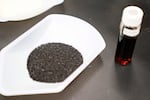The city of Vancouver is less than a quarter of the way to securing enough funding to mitigate toxic “forever chemicals” from its drinking water by 2029.
This week, the city announced it has secured a $10 million low-interest loan to build PFAS filtration systems, bringing its collection of grants and loans up to $37.5 million. In all, it needs to raise an estimated $210 million.
Vancouver is the third-largest municipal provider of drinking water in Washington. It’s among hundreds of water providers in the region that need to reduce PFAS to comply with national drinking water standards, which the U.S. Environmental Protection Agency announced this spring. They have less than five years to meet those standards.
PFAS are man-made chemicals that don’t break down, giving them the name “forever chemicals.” They accumulate in people’s blood over time, increasing people’s risk for cancer, high blood pressure and other harmful health effects that scientists are still studying.
Vancouver gets its water entirely from wells tapping into three underground aquifers, which are underground layers of rock and sand saturated in water. The city’s wells are divided between nine water stations. Of those, eight have exceeded federal PFAS limits in recent years.
PFAS were initially used in Teflon non-stick coatings in the 1940s, but lagging environmental regulations over the last eight decades have allowed them to make their way into a dizzying array of consumer products — lipstick, rain jackets, paper receipts, phone screens, takeout containers, yoga pants and shampoo, to name a few.
The chemicals flow through people’s bodies and into wastewater, or they can enter rivers and streams through firefighting foam and industrial plants, eventually seeping into drinking water aquifers and reservoirs.
Vancouver water officials say they’re unsure how PFAS are seeping into the city’s aquifers.
“We haven’t been able to find a single source of industrial contamination of our groundwater sites and why PFAS is there,” Vancouver civil engineer Mehrin Selimgir said. “It’s really spread out throughout our whole system.”

A sample of granular activated carbon, used to remove PFAS from water, on display during a tour of the U.S. Environmental Protection Agency Center For Environmental Solutions and Emergency Response, Feb. 14, 2023, in Cincinnati. Vancouver officials are investing in filtration systems that use granular activated carbon to pull PFAS out of its drinking water.
Joshua A. Bickel / AP
PFAS treatment systems can cost tens of millions of dollars. After finding high PFAS levels in drinking water, some utilities in Washington opted to find other water sources. Vancouver officials say that’s not a viable option for the city, so they’re investing in filtration systems that use granular activated carbon to pull PFAS out of its drinking water.
“You can kind of think of it as basically a larger scale Brita filter,” Selimgir said.
The city needs to build filtration systems for eight water stations. It’s currently in the design process for two of them. Staff prioritized Water Station 14, which has consistently had the highest PFAS levels. Workers will begin construction of its filtration system by the end of next year. It’s estimated to cost about $12.5 million, which is being covered by a forgivable loan from the state’s health department.
Vancouver is also finalizing designs for the Water Station 4 project, which is estimated to cost about $40 million. The city has raised about $25 million in grants and loans. Construction will begin in 2026.
Vancouver public works spokesperson Nicole Walters said the city is seeking other sources of funding for the remaining filtration systems so water users won’t see increasing rates.
“There will not be a direct line of cost to our customers for the upgrades needed over the next few years to meet EPA standards,” Walters said.
Public water providers need to start testing for six types of PFAS in drinking water by 2029. Washington got a head start in 2021 when it passed a bill requiring regular statewide monitoring. Since then, at least 200 water providers have found PFAS that exceeded federal limits, according to state data.
Selimgir said groundwater appears to be most susceptible to PFAS contamination, as opposed to surface water from streams and rivers.
“At least in the state of Washington, PFAS detections have been across the board at groundwater sources,” Selimgir said.
Oregon has so far taken a more piecemeal approach, mostly leaving it up to individual cities and water utilities to monitor PFAS. During a legislative committee meeting this week, Oregon Health Authority staff said the agency has tested just 4% of its 3,300 public water systems in recent years. Of those, 23 exceeded federal PFAS limits.
Chemical manufacturer 3M started making payments to public drinking water systems this year as part of a multi-billion-dollar settlement. Payouts will continue through 2036. Walters said Vancouver is among the water systems in that class-action lawsuit. It’s unclear how much money the city will be able to access as part of the settlement.
